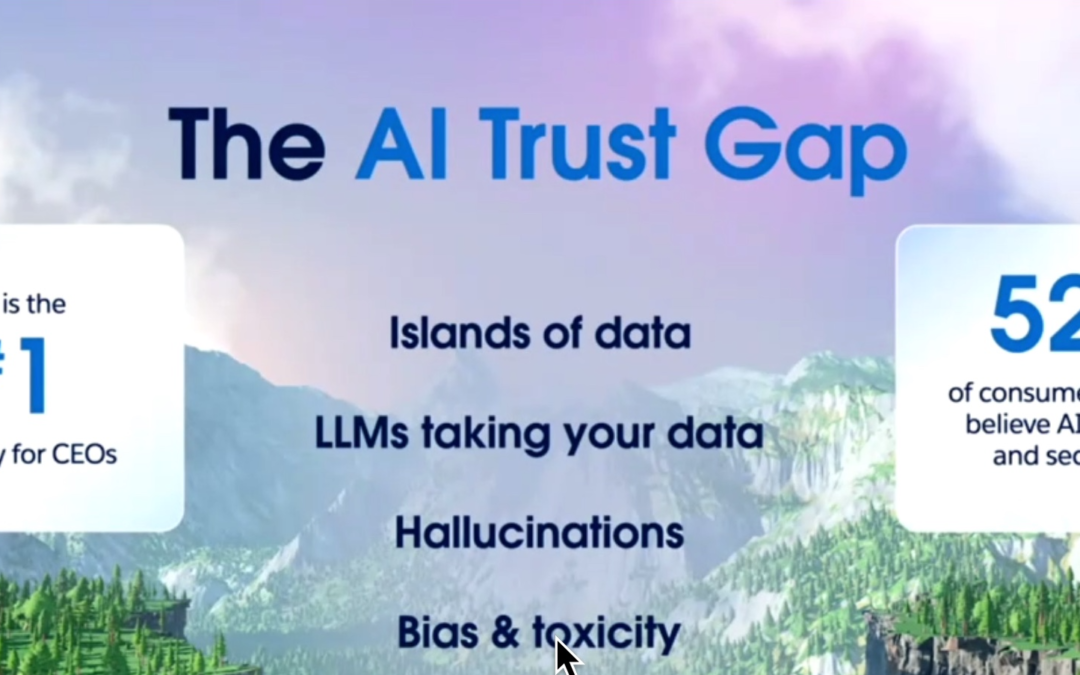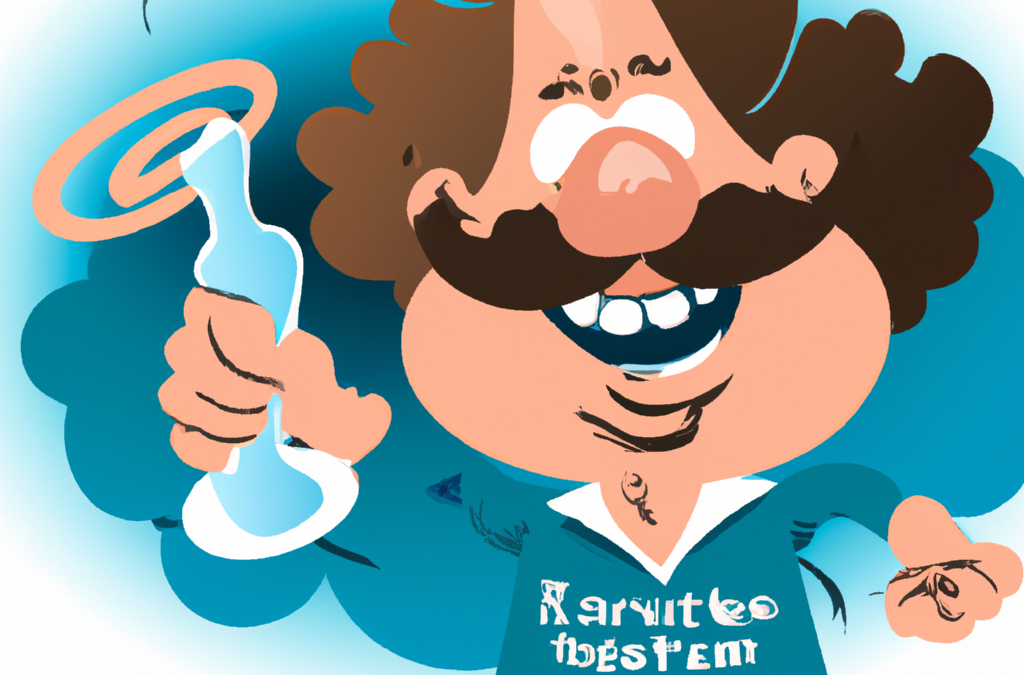
by twieberneit | Sep 12, 2023 | Analysis, Blog |
The News Dreamforce 2023 has started. It is the first post-Covid physical Dreamforce. The event has more than 40,000 participants from all over the world, which is almost small, considering past events. As usual, Dreamforce was opened by a keynote that was accompanied by a flurry of announcements. In an interesting twist, the keynote was accompanied by an analyst watch party held by Salesforce’s analyst relations. There was a “competing” watch party by the CRM Playaz. Not surprisingly, the topic of AI was front, right and center of the keynote after some emphasis on a culture of giving and the celebration of Salesforce as the #3 software vendor worldwide with an expected revenue of $34.8B US while continuing to lead the CRM market by a considerable margin. This is, indeed, quite an achievement. However, the focus of the keynote was set in the watch party by Salesforce’s Chief Enterprise Strategist Bruce Richardson with the following posting in the chat: “gen AI to boost global economy by $4.4 trillion. Since the release of ChatGPT in November 2022, it’s been all over the headlines, and businesses are racing to capture its value. Within the technology’s first few months, McKinsey research found that generative AI (gen AI) features stand to add up to $4.4 trillion to the global economy—annually. Source: McKinsey (August 23, 2023)” Consequently, much of what Salesforce currently does, capitalizes on this opportunity and helps businesses work with this opportunity. The key vehicles for this are the new Einstein 1 Platform and Einstein Copilot that comes together with a low code development environment Einstein Copilot Studio. Einstein Copilot is an “out of the box conversational AI assistant built into the user...

by twieberneit | Jun 23, 2023 | Analysis, Blog |
The news During the Salesforce AI Day on June 12 as well as the Salesforce AI Industry Analyst Forum on June 20, Salesforce provided a lot of interesting information on how the company addresses the challenge – or should I say problem – of trust into artificial intelligence. Salesforce sees this gap caused by hallucinations, lack of context and data security as well as toxicity and bias. According to Salesforce, this gets compounded by the need for integrating external models into business software. To address this problem, Salesforce has announced its AI Cloud that combines an “Einstein GPT Trust Layer”, Customer 360 and its CRM to offer AI-powered business processes that are built right into the system, based on an AI that can be trusted. The main vehicle is the Einstein GPT Trust Layer that takes care of secure data retrieval from business applications, dynamic grounding to reduce the risk of hallucinations and to increase response accuracy by automatically enriching prompts with relevant business-owned data, data masking, the anonymization of sensitive data to avoid its unintentional exposure of sensitive data to external tools, toxicity detection to make sure that generated content adheres to corporate policy, is free of unwanted words or images, and unbiased, creating and maintaining an audit trail, the external (or internal) AI not retaining, storing, any corporate information that gets sent to it via the request. This trust layer sits in between the used AI models and the apps and the respective development environments. All requests to the models, along with their data, get routed through this layer, ensuring authorization protected retrieval of data, the grounding...

by twieberneit | Jun 27, 2022 | Blog |
In the course of the last year or three, I have written a few times about the supply chain and how it affects the customer experience, sometimes badly so. In my last article ‘the impact of the supply chain on the customer experience’, I explained some of the issues and laid out a couple of high level solutions. Let me elaborate a little on what I wrote then. Of course, there are challenges in two main areas: The demand sideThe supply side The customer expectations are quite simple: A customer expects that things just work, that the vendor, and information given by the vendor, is reliable, accurate and comes timely; that deliveries after order are coming reasonably fast and that there is transparency about the order and delivery status. This is all quite abstract, so let us fill this with life. An example to the contrary goes as follows: You buy something, e.g., some whiteware, from a brand with a very high reputation; you are asked for upfront payment (several thousand dollar, remember, high reputation), get an approximate delivery date two months out – along with a warning that there may be a delay of a month or so. So far, so good. I could live with that although even the two months should be explained … Now, imagine that one month into the wait time you get an e-mail notifying you about a changed delivery date, pushing it out by a month. Well, not nice, but also not out of the range of expectations. After all you got told so. However, the next month you get a similar...

by Marshall Lager | Jun 1, 2021 | Blog, Sponsored |
The enterprise software world is one where few, if any, companies can stand alone. Cloud computing has greatly increased the availability and usability of business applications. However, no vendor can claim to supply a complete homegrown solution. The SaaS world is one of partnerships. Partnerships are best when all the partners are trustworthy.Business software customers still need to pick a brand and stick with it for a while. That brand—the platform—represents a serious investment of time and trust. Sure, you own your data, and changing platforms is supposed to be easy. But ask anybody who’s done it whether they would want to do so again next year.Platform customers have to weigh more than just the price and features of each platform provider. They must also consider what the future holds for that platform and its partners. None of the big platforms are likely to disappear or merge anytime soon, but their fates and fortunes are not constant. They also have histories and reputations. Increasingly, they have prominent social and/or political stances as well. Those issues matter enough to some business owners and investors to affect their decisions. There are also simpler matters, like whether the customer likes the feel of the software environment, or has concerns about possible changes. Can I Trust You? In the end, these decisions boil down to variations on a single question: “Can I trust you with my business?” Contracts and commercial laws deal with businesses that act in bad faith; this is more about responsibility, reliability, and safety. Examples: Will you continue to support the applications I use?Is my data secure?Do you have good...

by twieberneit | May 12, 2020 | Blog |
Let’s fast forward about 6 months and Imagine that the Corona crisis is over. Well, not really over, but being on a way of economic and especially psychologic recovery. There will be (yet another) new normal, a new equilibrium of life, personal as well as business. Societies, governments, economies and people have learned to deal with an unprecedented situation. How will the situation look like for businesses? And how will software vendors and consultants be able to improve the situation of their customers? Businesses were forced to a grinding stop, with obvious and disastrous results not only for themselves, but in particular for their customers’ experience. They will have seen huge losses, in spite of governments providing lots of stimulus in terms of trillions of dollars. Businesses more than ever before are facing the need to look precisely at where they spend their money and how they get their restart accomplished. Many people have seen or still are in unemployment. They need and want to contain their spending, too. Business leaders know that their situation has changed. They do know that they need to make their businesses more resilient. They surely have learned that a – to use this buzz word – digital transformation is not an option. It never was, but Covid-19 taught them the lesson that they severely underprioritized this topic. So the why and the what have been hammered down. What business leaders do not know is: How? They do not yet know how to recover and how to initiate or to continue their much-needed digital transformation. Overall, this translates into a situation of uncertainty for...






